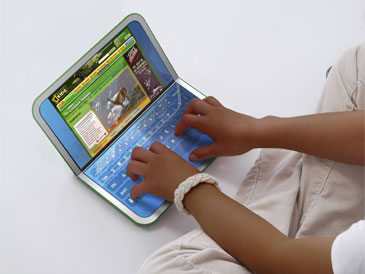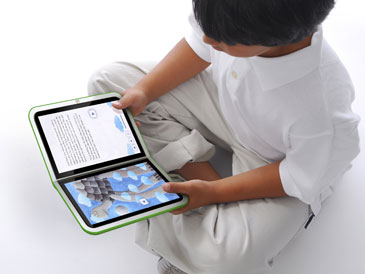One Laptop Per Child Frames Next Generation of Revolutionary XO Laptop
May 21, 2008 | 23:40
Companies: #olpc

CAMBRIDGE, Mass.--One Laptop per Child (OLPC), a non-profit organization focused on providing educational tools to help children in developing countries “learn learning,” announced today that work is already underway on a second- generation version of its revolutionary XO laptop computer. Leveraging new advances in technology, the primary goal of the “XO-2” will be to advance new concepts of learning as well as to further drive down the cost of the laptop so that it is affordable for volume purchase by developing nations.
“Based on feedback from governments, educators and most important, from the children themselves, we are aggressively working to lower the cost, power and size of the XO laptop so that it is more affordable and useable by the world’s poorest children,” said Nicholas Negroponte, founder and chairman of One Laptop per Child. “The delivery of the first generation XO laptop has sparked tremendous global interest in the project and provided valuable input on how to make the XO laptop an even better learning tool moving forward.”
“One Laptop per Child and the XO laptop are crucial to the fulfillment of the proposed UN Ninth Millennium Goal: to ensure that every child between the ages of 6 and 12 has immediate access to a personal laptop computer by 2015,” said Nirj Deva, Member of the European Parliament. “It’s only through access to education that young people will be able to develop the skills necessary to compete globally and to develop the solutions required to break the cycles of poverty, disease and malnutrition. Learning unites the child with the world, binds the village into a community, and joins that community to the global village.”
The first generation XO laptop went into production in early November 2007, and there are approximately 600,000 units in deployment in a number of countries including Peru, Uruguay, Mongolia, Haiti, Rwanda, Mexico, Cambodia, Ethiopia, Ghana, Iraq, Afghanistan, and the US and Canada (as a result of the Give One Get One charitable giving campaign that ran last November 12 – December 31, 2007). Key goals for the XO-2 include:
Availability of the XO-2 is planned for delivery in 2010. XO-1.5 will be released in the spring of 2009 with the same design as the first generation but with fewer physical parts and at a lower cost than XO-1.


About One Laptop per Child
One Laptop per Child (OLPC at www.laptop.org) is a non-profit organization created by Nicholas Negroponte and others from the MIT Media Lab to design, manufacture and distribute laptop computers that are sufficiently inexpensive to provide every child in the world access to knowledge and modern forms of education. These XO laptops are rugged, open source, and so energy efficient that they can be powered by a child manually. Mesh networking gives many machines Internet access from one connection.
“Based on feedback from governments, educators and most important, from the children themselves, we are aggressively working to lower the cost, power and size of the XO laptop so that it is more affordable and useable by the world’s poorest children,” said Nicholas Negroponte, founder and chairman of One Laptop per Child. “The delivery of the first generation XO laptop has sparked tremendous global interest in the project and provided valuable input on how to make the XO laptop an even better learning tool moving forward.”
“One Laptop per Child and the XO laptop are crucial to the fulfillment of the proposed UN Ninth Millennium Goal: to ensure that every child between the ages of 6 and 12 has immediate access to a personal laptop computer by 2015,” said Nirj Deva, Member of the European Parliament. “It’s only through access to education that young people will be able to develop the skills necessary to compete globally and to develop the solutions required to break the cycles of poverty, disease and malnutrition. Learning unites the child with the world, binds the village into a community, and joins that community to the global village.”
The first generation XO laptop went into production in early November 2007, and there are approximately 600,000 units in deployment in a number of countries including Peru, Uruguay, Mongolia, Haiti, Rwanda, Mexico, Cambodia, Ethiopia, Ghana, Iraq, Afghanistan, and the US and Canada (as a result of the Give One Get One charitable giving campaign that ran last November 12 – December 31, 2007). Key goals for the XO-2 include:
- Cost Reduction – Set in early 2005, the original target price of the XO laptop was $100. Although that target has not yet been met (it is now at $188), it is clear that OLPC must aim for an even lower target price of $75. New developments in display, processor and other hardware and software technologies will make it possible to achieve the $75 target in the future.
- Lower Power Consumption – While the first generation XO laptop already requires just one-tenth (2-4 watts versus 20-40 watts) of the electrical power necessary to run a standard laptop, the XO-2 will reduce power consumption even further to 1 watt. This is particularly important for children in remote and rural environments where electricity is scarce or non-existent. Lowering the power consumption will reduce the amount of time required for children to generate power themselves via a hand crank or other manual mechanisms.
- Smaller Footprint – The XO-2 laptop will be about half the size of the first generation device and will approximate the size of a book. The new design will make the XO laptop lighter and easier for children to carry with them to and from school or wherever they go. The XO-2 will continue to be in a green and white case and sport the XO logo in a multitude of colors that allow children to personalize the laptop as their own possession.
- Enhanced Book Experience – Dual-touch sensitive displays will be used to enhance the e-book experience, with a dual-mode display similar to the current XO laptop. The design provides a right and left page in vertical format, a hinged laptop in horizontal format, and a flat two-screen wide continuous surface that can be used in tablet mode. Younger children will be able to use simple keyboards to get going, and older children will be able to switch between keyboards customized for applications as well as for multiple languages. The dual-touch display is being designed by Pixel Qi, which was founded in early 2008 by Mary Lou Jepsen, former chief technology officer of One Laptop per Children and a leading expert on display technology.
Availability of the XO-2 is planned for delivery in 2010. XO-1.5 will be released in the spring of 2009 with the same design as the first generation but with fewer physical parts and at a lower cost than XO-1.


About One Laptop per Child
One Laptop per Child (OLPC at www.laptop.org) is a non-profit organization created by Nicholas Negroponte and others from the MIT Media Lab to design, manufacture and distribute laptop computers that are sufficiently inexpensive to provide every child in the world access to knowledge and modern forms of education. These XO laptops are rugged, open source, and so energy efficient that they can be powered by a child manually. Mesh networking gives many machines Internet access from one connection.

MSI MPG Velox 100R Chassis Review
October 14 2021 | 15:04





Want to comment? Please log in.